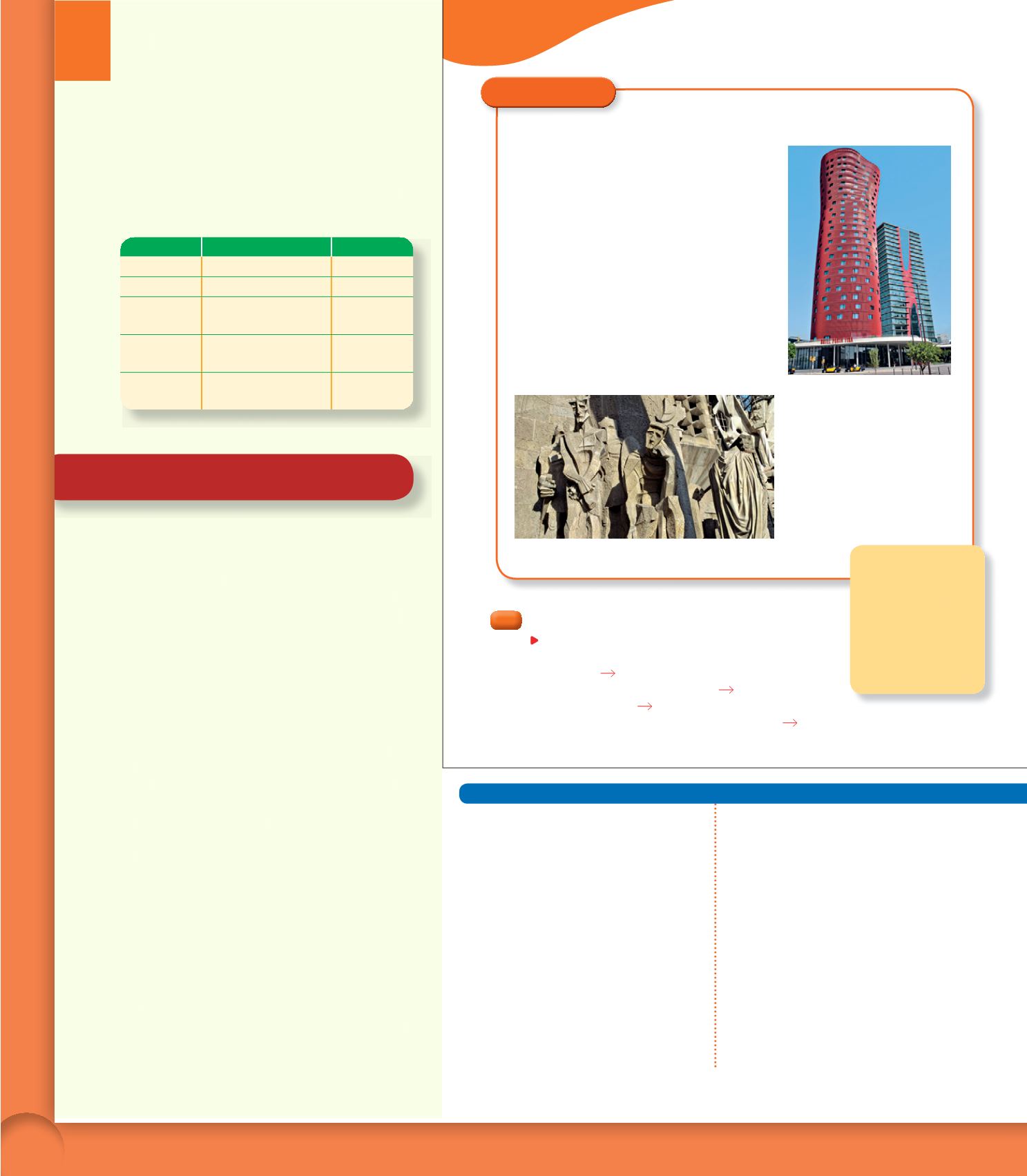

Book 4 Unit 6
86
Presentation
.
In this section, students will learn vocabulary to
talk about architecture and sculpture.
Activities
Standards
Resources
Vocabulario 1.2, 2.1, 2.2, 3.1
36.
1.3, 3.1
37.
1.1, 1.3, 2.1, 2.2,
3.1, 4.2, 5.1, 5.2
38.
1.1, 1.2, 2.1, 2.2,
3.1, 5.1
Audio
39. Cultura
1.2, 1.3, 2.1, 2.2,
3.1, 5.1
Teaching Suggestions
Warm-Up/ Independent Starter
.
Ask students to create a two-column chart with
these headings:
Nombres, Adjetivos.
Then have
them read the first paragraph of the vocabulary
presentation silently and classify the highlighted
words in their charts.
Preparation
.
Read the vocabulary presentation and the
Más
vocabulario
feature aloud to demonstrate correct
pronunciation, and have students repeat the
highlighted words after you. Then ask them to
complete their charts. Next, have students fill in
the
Adjetivos
column with adjectives that would
form logical pairs with the nouns in the
Nombres
column (e.g.,
catedral
–
vanguardista
). Invite
students to share their charts with a partner and
come up with six to seven sentences in which
they use some of their noun-adjective pairs.
.
For further practice with this vocabulary, ask
students to research one of the works mentioned
in the presentation for homework. They should
prepare to present their work to the class.
Activities
36.
Have students write definitions for some of the
words they listed. Then ask them to have their
peers guess the vocabulary defined. You may
wish to turn this into a competition.
Vocabulario – Arquitectura
y escultura
DESAFÍO 2
Unit
6
DEVELOPING LEARNERS
r
Ask students to match the words.
1.
acueducto
(g)
a.
en realidad
2.
rascacielos
(f) b.
material de
construcción
3.
puente
(h)
c.
residencia de
un monarca
4.
actual
(i)
d.
piedra
5.
ladrillo
(b)
e.
residencia
6.
fachada
(j)
f.
edificio muy alto
7.
de hecho
(a)
g.
lleva el agua
8.
mármol
(d)
h.
va sobre un río
9.
vivienda
(e)
i.
presente
10.
palacio
(c)
j.
parte exterior de
un edificio
EXPANDING LEARNERS
r
Ask students to imagine that their city
council is considering demolishing an
emblematic building in their community in
order to put up a shopping mall. Some
students will be in favor of this plan, while
others oppose it. All students will write a
letter to convince their community
government to either go ahead with their
plans and tear down the building or to
preserve it. Students will need to state the
advantages of their argument and the
disadvantages of the opposition. Call on
students to read their letters aloud.
Differentiated Instruction
Arquitectura y escultura
6
3
Categorías
Escribe
una lista de términos para cada categoría. Incluye
palabras de la ficha de Vocabulario y otras que conozcas.
1.
Materiales.
acero, bronce, hierro...
2.
Tipos de edificios y construcciones.
iglesia...
3.
Partes de edificios.
fachada...
4.
Acciones asociadas con arquitectos y escultores.
diseñar...
DESAFÍO 2
Más vocabulario
Materiales
el hierro
iron
el ladrillo
brick
el mármol
marble
¡Atención!
actualmente
currently
de hecho
actually
Vocabulario
La arquitectura es el arte de diseñar edificios y
construcciones
de todo tipo: edificios religiosos
como
catedrales
,
mezquitas
,
templos
o
sinagogas
, con
impresionantes
arcos
y
columnas
o altísimas
torres
,
y también
lujosos palacios
y
viviendas
.
A lo largo de la historia las distintas civilizaciones
nos han ido dejando verdaderas obras de arte, no solo
pertenecientes al período clásico de los griegos y los
romanos (como el famoso
acueducto
de Segovia, del
siglo
I
), sino también a la arquitectura moderna y
contemporánea.
De hecho
, muchos
rascacielos
(como el
famosísimo Empire State) y
puentes
(como el Golden Gate)
se consideran maravillas arquitectónicas.
Actualmente
no solo se emplean materiales tradicionales
como la
piedra
, el
granito
, el
cemento
o el
concreto
, sino
otros más modernos como el
cristal
o el
aluminio
y otros
metales.
En muchas ocasiones, la escultura
está íntimamente unida a la
arquitectura, como es el caso de la
fachada
de la Sagrada Familia de
Gaudí. Las figuras fueron
esculpidas
por varios artistas dirigidos por
el propio Gaudí.
Hotel Santos Porta Fira (Barcelona).
Conjunto escultórico de la Sagrada Familia (Barcelona).
318


















